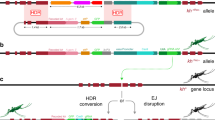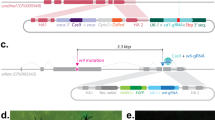Abstract
Gene drives are genetic elements that are transmitted to greater than 50% of offspring and have potential for population modification or suppression. While gene drives are known to occur naturally, the recent emergence of CRISPR-Cas9 genome-editing technology has enabled generation of synthetic gene drives in a range of organisms including mosquitos, flies, and yeast. For example, studies in Anopheles mosquitos have demonstrated >95% transmission of CRISPR-engineered gene drive constructs, providing a possible strategy for malaria control. Recently published studies have also indicated that it may be possible to develop gene drive technology in invasive rodents such as mice. Here, we discuss the prospects for gene drive development in mice, including synthetic “homing drive” and X-shredder strategies as well as modifications of the naturally occurring t haplotype. We also provide detailed protocols for generation of gene drive mice through incorporation of plasmid-based transgenes in a targeted and non-targeted manner. Importantly, these protocols can be used for generating transgenic mice for any project that requires insertion of kilobase-scale transgenes such as knock-in of fluorescent reporters, gene swaps, overexpression/ectopic expression studies, and conditional “floxed” alleles.
Access this chapter
Tax calculation will be finalised at checkout
Purchases are for personal use only
Similar content being viewed by others
References
Pimentel D, Zuniga R, Morrison D (2005) Update on the environmental and economic costs associated with alien-invasive species in the United States. Ecol Econ 52(3):273–288
Stenseth NC et al (2003) Mice, rats, and people: the bio-economics of agricultural rodent pests. Front Ecol Environ 1(7):367–375
McLeod R (2004) Counting the cost: impact of invasive animals in Australia. Cooperative Research Centre for Pest Animal Control, Canberra
Blackburn TM et al (2004) Avian extinction and mammalian introductions on oceanic Islands. Science 305(5692):1955–1958
Harris DB (2008) Review of negative effects of introduced rodents on small mammals on islands. Biol Invasions 11(7):1611–1630
Doherty TS et al (2016) Invasive predators and global biodiversity loss. Proc Natl Acad Sci U S A 113(40):11261–11265
Piaggio AJ et al (2017) Is it time for synthetic biodiversity conservation? Trends Ecol Evol 32(2):97–107
Gregory S et al (2014) Eradications of vertebrate pests in Australia: a review and guidelines for future best practice. Invasive Animals Cooperative Research Centre, Canberra, Australia, pp 1–90
Esvelt KM et al (2014) Concerning RNA-guided gene drives for the alteration of wild populations. elife 3:e03401
Burt A (2003) Site-specific selfish genes as tools for the control and genetic engineering of natural populations. Proc Biol Sci 270(1518):921–928
Cong L et al (2013) Multiplex genome engineering using CRISPR/Cas systems. Science 339(6121):819–823
Jinek M et al (2012) A Programmable dual-RNA—guided DNA endonuclease in adaptive bacterial immunity. Science 337(6096):816–821
Prowse TAA et al (2017) Dodging silver bullets: good CRISPR gene-drive design is critical for eradicating exotic vertebrates. Proc Biol Sci 284(1860):20170799
Galizi R et al (2014) A synthetic sex ratio distortion system for the control of the human malaria mosquito. Nat Commun 5:3977
Simoni A et al (2020) A male-biased sex-distorter gene drive for the human malaria vector Anopheles gambiae. Nat Biotechnol 38(9):1054–1060
Kyrou K et al (2018) A CRISPR-Cas9 gene drive targeting doublesex causes complete population suppression in caged Anopheles gambiae mosquitoes. Nat Biotechnol 36(11):1062–1066
Hammond A et al (2016) A CRISPR-Cas9 gene drive system targeting female reproduction in the malaria mosquito vector Anopheles gambiae. Nat Biotechnol 34(1):78–83
Haghighat-Khah RE et al (2020) Cellular mechanisms regulating synthetic sex ratio distortion in the Anopheles gambiae germline. Pathog Glob Health 114(7):370–378
Gantz VM et al (2015) Highly efficient Cas9-mediated gene drive for population modification of the malaria vector mosquito Anopheles stephensi. Proc Natl Acad Sci U S A 112(49):E6736–E6743
Champer SE et al (2021) Modeling CRISPR gene drives for suppression of invasive rodents using a supervised machine learning framework. PLoS Comput Biol 17(12):e1009660
Grunwald HA et al (2019) Super-Mendelian inheritance mediated by CRISPR-Cas9 in the female mouse germline. Nature 566(7742):105–109
Pfitzner C et al (2020) Progress toward zygotic and germline gene drives in mice. CRISPR J 3(5):388–397
Gallardo T et al (2007) Generation of a germ cell-specific mouse transgenic Cre line. Vasa-Cre Genesis 45(6):413–417
Champer J et al (2018) Reducing resistance allele formation in CRISPR gene drive. Proc Natl Acad Sci U S A 115(21):5522–5527
Unckless RL, Clark AG, Messer PW (2017) Evolution of resistance against CRISPR/Cas9 gene drive. Genetics 205(2):827–841
Noble C et al (2017) Evolutionary dynamics of CRISPR gene drives. Sci Adv 3(4):e1601964
Champer SE et al (2020) Computational and experimental performance of CRISPR homing gene drive strategies with multiplexed gRNAs. Sci Adv 6(10):eaaz0525
Lyttle TW (1991) Segregation distorters. Annu Rev Genet 1991:511–577
McFarlane GR, Whitelaw CBA, Lillico SG (2018) CRISPR-based gene drives for pest control. Trends Biotechnol 36(2):130–133
Burt A, Deredec A (2018) Self-limiting population genetic control with sex-linked genome editors. Proc Biol Sci 285(1883):20180776. https://doi.org/10.1098/rspb.2018.0776
Zuo E et al (2017) CRISPR/Cas9-mediated targeted chromosome elimination. Genome Biol 18(1):224
Prowse TA et al (2019) A Y-chromosome shredding gene drive for controlling pest vertebrate populations. elife 8
Kelemen RK, Vicoso B (2018) Complex history and differentiation patterns of the t-Haplotype, a mouse meiotic driver. Genetics 208(1):365–375
Koopman P et al (1991) Male development of chromosomally female mice transgenic for Sry. Nature 351(6322):117–121
Backus GA, Gross K (2016) Genetic engineering to eradicate invasive mice on islands: modeling the efficiency and ecological impacts. Ecosphere 7(12):e01589
Manser A et al (1909) Controlling invasive rodents via synthetic gene drive and the role of polyandry. Proc Biol Sci 2019(286):20190852
Manser A, Konig B, Lindholm AK (2020) Polyandry blocks gene drive in a wild house mouse population. Nat Commun 11(1):5590
Kandul NP et al (2020) Assessment of a split homing based gene drive for efficient knockout of multiple genes. G3 (Bethesda) 10(2):827–837
Noble C et al (2019) Daisy-chain gene drives for the alteration of local populations. Proc Natl Acad Sci U S A 116(17):8275–8282
Sudweeks J et al (2019) Locally fixed alleles: a method to localize gene drive to island populations. Sci Rep 9(1):15821
Lopez Del Amo V et al (2020) Small-molecule control of super-mendelian inheritance in gene drives. Cell Rep 31(13):107841
Author information
Authors and Affiliations
Corresponding author
Editor information
Editors and Affiliations
Rights and permissions
Copyright information
© 2022 The Author(s), under exclusive license to Springer Science+Business Media, LLC, part of Springer Nature
About this protocol
Cite this protocol
Bunting, M.D., Pfitzner, C., Gierus, L., White, M., Piltz, S., Thomas, P.Q. (2022). Generation of Gene Drive Mice for Invasive Pest Population Suppression. In: Verma, P.J., Sumer, H., Liu, J. (eds) Applications of Genome Modulation and Editing. Methods in Molecular Biology, vol 2495. Humana, New York, NY. https://doi.org/10.1007/978-1-0716-2301-5_11
Download citation
DOI: https://doi.org/10.1007/978-1-0716-2301-5_11
Published:
Publisher Name: Humana, New York, NY
Print ISBN: 978-1-0716-2300-8
Online ISBN: 978-1-0716-2301-5
eBook Packages: Springer Protocols




